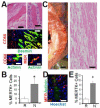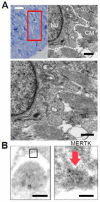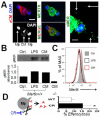Cardiomyocytes induce macrophage receptor shedding to suppress phagocytosis
- PMID: 26316303
- PMCID: PMC4637185
- DOI: 10.1016/j.yjmcc.2015.08.009
Cardiomyocytes induce macrophage receptor shedding to suppress phagocytosis
Abstract
Background: Mobilization of the innate immune response to clear and metabolize necrotic and apoptotic cardiomyocytes is a prerequisite to heart repair after cardiac injury. Suboptimal kinetics of dying myocyte clearance leads to secondary necrosis, and in the case of the heart, increased potential for collateral loss of neighboring non-regenerative myocytes. Despite the importance of myocyte phagocytic clearance during heart repair, surprisingly little is known about its underlying cell and molecular biology.
Objective: To determine if phagocytic receptor MERTK is expressed in human hearts and to elucidate key sequential steps and phagocytosis efficiency of dying adult cardiomyocytes, by macrophages.
Results: In infarcted human hearts, expression profiles of the phagocytic receptor MER-tyrosine kinase (MERTK) mimicked that found in experimental ischemic mouse hearts. Electron micrographs of myocardium identified MERTK signal along macrophage phagocytic cups and Mertk-/- macrophages contained reduced digested myocyte debris after myocardial infarction. Ex vivo co-culture of primary macrophages and adult cardiomyocyte apoptotic bodies revealed reduced engulfment relative to resident cardiac fibroblasts. Inefficient clearance was not due to the larger size of myocyte apoptotic bodies, nor were other key steps preceding the formation of phagocytic synapses significantly affected; this included macrophage chemotaxis and direct binding of phagocytes to myocytes. Instead, suppressed phagocytosis was directly associated with myocyte-induced inactivation of MERTK, which was partially rescued by genetic deletion of a MERTK proteolytic susceptibility site.
Conclusion: Utilizing an ex vivo co-cultivation approach to model key cellular and molecular events found in vivo during infarction, cardiomyocyte phagocytosis was found to be inefficient, in part due to myocyte-induced shedding of macrophage MERTK. These findings warrant future studies to identify other cofactors of macrophage-cardiomyocyte cross-talk that contribute to cardiac pathophysiology.
Keywords: Acute myocardial infarction; Animal models of human disease; Cardiomyocyte; Phagocytosis.
Copyright © 2015 Elsevier Ltd. All rights reserved.
Figures








Similar articles
-
Enhanced efferocytosis of apoptotic cardiomyocytes through myeloid-epithelial-reproductive tyrosine kinase links acute inflammation resolution to cardiac repair after infarction.Circ Res. 2013 Sep 27;113(8):1004-12. doi: 10.1161/CIRCRESAHA.113.301198. Epub 2013 Jul 8. Circ Res. 2013. PMID: 23836795 Free PMC article.
-
Myeloid receptor CD36 is required for early phagocytosis of myocardial infarcts and induction of Nr4a1-dependent mechanisms of cardiac repair.FASEB J. 2018 Jan;32(1):254-264. doi: 10.1096/fj.201700450R. Epub 2017 Aug 31. FASEB J. 2018. PMID: 28860151 Free PMC article.
-
MerTK Cleavage on Resident Cardiac Macrophages Compromises Repair After Myocardial Ischemia Reperfusion Injury.Circ Res. 2017 Sep 29;121(8):930-940. doi: 10.1161/CIRCRESAHA.117.311327. Epub 2017 Aug 29. Circ Res. 2017. PMID: 28851810 Free PMC article.
-
Phagocyte-myocyte interactions and consequences during hypoxic wound healing.Cell Immunol. 2014 Sep-Oct;291(1-2):65-73. doi: 10.1016/j.cellimm.2014.04.006. Epub 2014 May 2. Cell Immunol. 2014. PMID: 24862542 Free PMC article. Review.
-
Mechanisms of failed apoptotic cell clearance by phagocyte subsets in cardiovascular disease.Apoptosis. 2010 Sep;15(9):1124-36. doi: 10.1007/s10495-010-0516-6. Apoptosis. 2010. PMID: 20552278 Free PMC article. Review.
Cited by
-
Three in a Box: Understanding Cardiomyocyte, Fibroblast, and Innate Immune Cell Interactions to Orchestrate Cardiac Repair Processes.Front Cardiovasc Med. 2019 Apr 2;6:32. doi: 10.3389/fcvm.2019.00032. eCollection 2019. Front Cardiovasc Med. 2019. PMID: 31001541 Free PMC article. Review.
-
SheddomeDB: the ectodomain shedding database for membrane-bound shed markers.BMC Bioinformatics. 2017 Mar 14;18(Suppl 3):42. doi: 10.1186/s12859-017-1465-7. BMC Bioinformatics. 2017. PMID: 28361715 Free PMC article. Review.
-
Macrophages in cardiac remodelling after myocardial infarction.Nat Rev Cardiol. 2023 Jun;20(6):373-385. doi: 10.1038/s41569-022-00823-5. Epub 2023 Jan 10. Nat Rev Cardiol. 2023. PMID: 36627513 Review.
-
Cardiomyocytes and Macrophages Discourse on the Method to Govern Cardiac Repair.Front Cardiovasc Med. 2018 Oct 2;5:134. doi: 10.3389/fcvm.2018.00134. eCollection 2018. Front Cardiovasc Med. 2018. PMID: 30333983 Free PMC article. Review.
-
The efferocytosis process in aging: Supporting evidence, mechanisms, and therapeutic prospects for age-related diseases.J Adv Res. 2025 Mar;69:31-49. doi: 10.1016/j.jare.2024.03.008. Epub 2024 Mar 17. J Adv Res. 2025. PMID: 38499245 Free PMC article. Review.
References
-
- Aderem A. How to eat something bigger than your head. Cell. 2002;110(1):5–8. - PubMed
-
- Camenisch TD, Koller BH, et al. A novel receptor tyrosine kinase, Mer, inhibits TNF-alpha production and lipopolysaccharide-induced endotoxic shock. J Immunol. 1999;162(6):3498–3503. - PubMed
-
- Cannon GJ, Swanson JA. The macrophage capacity for phagocytosis. J Cell Sci. 1992;101(Pt 4):907–913. - PubMed
Publication types
MeSH terms
Substances
Grants and funding
LinkOut - more resources
Full Text Sources
Other Literature Sources
Medical
Molecular Biology Databases
Miscellaneous

